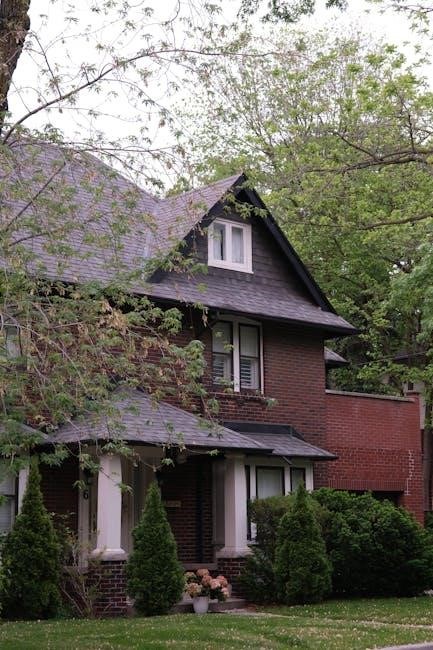The Ontario Residential Property Application Form is a crucial document for property transactions, streamlining processes and ensuring legal compliance. It facilitates purchases, sales, and ownership transfers efficiently.
Overview of the Application Process
The Ontario Residential Property Application Form streamlines property transactions, ensuring compliance with provincial regulations. It involves verifying eligibility, preparing documentation, and submitting the form either online or offline. The process begins with applicant eligibility checks, followed by document submission and fee payment. Once processed, the form undergoes review, and applicants receive updates through digital platforms or mail. The system ensures transparency, efficiency, and adherence to legal standards for property-related matters in Ontario.
Applicants can track their application status online, reducing wait times and improving accessibility. The process is designed to simplify residential property transactions, making it easier for individuals to navigate Ontario’s real estate landscape effectively.
Importance of the Form for Property Transactions

The Ontario Residential Property Application Form is essential for ensuring transparency and accountability in property transactions. It provides a standardized method for collecting necessary information, protecting both buyers and sellers. By detailing property specifics and legal compliance, the form safeguards against disputes and fraud. Its use is mandated to maintain accurate records and uphold provincial regulations, ensuring smooth transactions and fair dealings in Ontario’s real estate market.
It also supports government oversight, enabling authorities to track property ownership and enforce land-use policies effectively.

Eligibility Criteria for Submitting the Form
Applicants must be Ontario residents and property owners. They must meet specific legal and documentation requirements to ensure eligibility for form submission and processing.
Residency Requirements for Applicants
To qualify, applicants must be permanent Ontario residents, demonstrating intent to live in the province. Residency is typically proven through government-issued ID, utility bills, or tax filings. Applicants must maintain a primary residence in Ontario, ensuring compliance with provincial regulations for property transactions. This requirement helps verify legal standing and eligibility for specific benefits or exemptions related to property ownership in the province. Proper documentation is essential to avoid processing delays or form rejection.
Property Ownership and Related Documentation
Applicants must provide proof of property ownership, such as a deed or purchase agreement. Additional documentation may include property tax bills, assessment notices, and zoning permits. These records verify ownership and ensure compliance with legal standards. In cases of shared ownership, all parties must be listed. Accurate and complete documentation is critical to avoid delays or form rejection. Proper records also help establish the property’s legal status and value for transaction purposes.

Required Documents for the Application
The application requires personal identification, property tax statements, income verification, and ownership documents. Additional records like assessment reports and zoning permits may also be necessary.
Personal Identification and Income Proof
Applicants must provide valid government-issued identification, such as a passport or driver’s license. Income verification, including recent pay stubs or tax returns, is essential to assess financial eligibility. Additional documentation, like bank statements or employment letters, may be requested to confirm stability and capacity to manage property-related obligations. Ensuring accuracy and completeness in these documents is crucial for a smooth application process and compliance with regulatory requirements.
Property Assessment and Valuation Reports
Property assessment and valuation reports are critical for determining the market value of a residential property. These reports, conducted by certified professionals, provide detailed insights into the property’s condition, size, and location. They ensure compliance with tax regulations and help in accurate valuation for transactions. Applicants must submit these reports to verify property details, facilitating smooth processing of the application. Failure to provide valid reports may delay or reject the application, emphasizing their importance in the process.
Step-by-Step Guide to Filling the Form
A step-by-step guide helps applicants navigate the form efficiently. It covers sections like applicant information, property details, and financial data. Each part has specific requirements to ensure accuracy and compliance.
Section 1: Applicant Information
Section 1 requires detailed applicant information, including full name, residential address, contact details, and ownership status. Applicants must specify if they are individual owners, joint owners, or representing a legal entity. Additional fields may include citizenship status or trust information, ensuring transparency and compliance with legal requirements. Accurate and complete submission of this section is essential to avoid delays in processing. Proper verification of applicant identity is also mandated to maintain the integrity of the application process and prevent fraudulent activities.
Section 2: Property Details and Description
Section 2 focuses on providing detailed information about the residential property, including the property address, tax identification number, and legal description. Applicants must specify the type of property, such as single-family home, condominium, or vacant land. Additional details like property size, zoning classification, and location are required to ensure accurate assessment. This section also includes fields for describing improvements or structures on the property, such as garages or pools, to facilitate smooth transactions and compliance with legal standards.
Section 3: Financial and Tax Information
Section 3 requires applicants to provide detailed financial and tax information related to the property. This includes property tax payments, outstanding balances, and any tax exemptions or reductions. Applicants must disclose all income sources derived from the property, such as rental income, and detail any financial liabilities or encumbrances. Accurate reporting is crucial to ensure compliance with tax regulations and to facilitate a smooth application process. Supporting documentation may be requested to validate the information provided.
Fees and Payment Methods
The Ontario Residential Property Application Form requires payment of a standard fee, with options for credit card, check, or online transfer. Additional charges may apply.
Application Fees and Additional Charges
The Ontario Residential Property Application Form requires a standard fee, which varies based on property type and location. Additional charges may apply for expedited processing or special requests. Payment methods include credit cards, checks, or online transfers. Refunds are typically not issued once the application is submitted. Ensure all fees are paid in full to avoid delays in processing. Late payments may incur penalties. Always verify the current fee schedule before submitting your application.
Accepted Payment Methods and Refund Policies
The Ontario Residential Property Application Form accepts various payment methods, including online payments via credit/debit cards, e-transfer, or checks. In-person payments are also available at designated service centers. Refunds are processed within 10-15 business days, provided the application meets all criteria. Fees are non-refundable once processing has begun. Refunds are issued via the original payment method. Ensure payment details are accurate to avoid delays. For more information, consult the official Ontario government website or contact customer support.
Submission and Processing
The Ontario Residential Property Application Form can be submitted online or in person. Processing times vary, but applicants can track their application status online for updates.
Online Submission and Digital Signature
The Ontario Residential Property Application Form supports online submission through a secure digital portal. Applicants can complete and sign the form electronically using a digital signature, ensuring authenticity and convenience. This method streamlines the process, reducing paperwork and processing times. The system is designed with robust security measures to protect sensitive information. Once submitted, applicants receive a confirmation and can track the status of their application in real-time. This approach enhances efficiency and accessibility, making it easier to manage property transactions remotely. Online submissions are also environmentally friendly, reducing the need for physical documents. The digital signature feature ensures that the application is legally binding and adheres to provincial regulations. This modern approach aligns with the province’s efforts to offer user-friendly and efficient services for residents and property owners. By leveraging technology, the application process becomes faster and more transparent, benefiting all parties involved. The online platform is available 24/7, allowing applicants to submit their forms at their convenience. This digital solution is part of Ontario’s commitment to improving access to government services and promoting a seamless experience for property transactions. The integration of digital signatures further enhances the security and integrity of the application process, ensuring that all submissions are valid and enforceable. Overall, the online submission and digital signature features make the Ontario Residential Property Application Form a modern and efficient tool for property-related matters.
Offline Submission and Required Signatures
The Ontario Residential Property Application Form can also be submitted offline by downloading and printing the form from the official website. Applicants must complete the form manually and sign it in the presence of a witness or notary, depending on the requirements. All signatures must be original and wet-inked to ensure authenticity. Completed forms are then mailed or delivered in person to the designated office. This method ensures compliance with legal standards and provides a physical record of the transaction. Offline submissions require careful attention to detail to avoid processing delays. Proper signatures are essential for validating the application and ensuring it is legally binding. This traditional method remains a reliable option for those preferring paper-based processes or lacking access to digital tools. The offline submission process is straightforward but requires adherence to specific guidelines to maintain the integrity of the application. It is recommended to keep a copy of the signed form for personal records. This approach ensures that all parties involved can verify the authenticity of the application manually. Offline submissions are particularly useful in areas with limited internet access, ensuring equal access to property transactions. The process underscores the importance of physical documentation in certain legal contexts. Overall, offline submission remains a viable and secure method for completing the Ontario Residential Property Application Form.
Processing Times and Status Updates
The Ontario Residential Property Application Form typically takes 4-6 weeks for processing. Applicants can track their application status online through the official portal or receive updates via email notifications.

Expected Timeframes for Application Review
The Ontario Residential Property Application Form typically undergoes review within 4-6 weeks. Processing times may vary due to application complexity, document completeness, and seasonal workload. Applicants can expect delays if additional information or clarifications are required. Online tracking systems provide real-time updates, ensuring transparency throughout the process. It is essential to submit all required documents promptly to avoid extended review periods and ensure a smooth application experience.
Tracking Application Status Online
Applicants can conveniently track their Ontario Residential Property Application Form status through the official government portal. By logging into their account, users can monitor progress in real-time, receive updates, and access notifications. This secure online system ensures transparency and efficiency, reducing the need for phone inquiries. Additionally, automated email notifications are sent at key stages, keeping applicants informed throughout the review process. This digital solution saves time and enhances the overall application experience.

Post-Submission Requirements
Post-submission requirements ensure compliance, including document verification, property inspections, and potential requests for additional information to finalize the application process efficiently.

Inspections and Site Visits
Inspections and site visits are conducted to verify property details, ensuring compliance with local regulations. These may include assessments of property condition, zoning adherence, and environmental factors. Municipal officials or authorized representatives typically perform these evaluations. Applicants should prepare by granting access and providing necessary documentation. The findings from these inspections are crucial for finalizing approvals and ensuring all legal and safety standards are met before property transactions are completed.
Additional Documentation Requests
Applicants may be required to submit supplementary documents to support their property application. This could include updated property surveys, title searches, or environmental assessments. Authorities may request proof of ownership, tax receipts, or compliance certificates. Providing these documents promptly ensures the process remains uninterrupted. Failure to submit required paperwork may delay approvals. Applicants should maintain organized records to facilitate quick retrieval and submission of any additional materials requested during the review period.

Property Tax Implications
The Ontario Residential Property Application Form plays a key role in determining property taxes, influencing tax calculations based on property value and ensuring fair distribution across Ontario.
Understanding Tax Calculations
The Ontario Residential Property Application Form is essential for determining property taxes, as it provides detailed property valuations and ownership information. Tax calculations are based on the assessed property value, which is determined by the Municipal Property Assessment Corporation (MPAC). The tax rate is then applied to this value, with adjustments for exemptions or reductions. This process ensures fair taxation across Ontario, with revenues supporting local services and infrastructure. Understanding these calculations helps property owners manage their financial obligations effectively.
Exemptions and Reductions Available
The Ontario Residential Property Application Form allows property owners to claim exemptions or reductions, lowering their tax burden. These include exemptions for residential properties, heritage designations, or agricultural land. Reductions may apply for seniors, veterans, or properties used for charitable purposes. Eligibility varies, and applicants must submit supporting documents. Understanding these options can significantly reduce tax liabilities, making property ownership more affordable. The form ensures clarity in applying for such exemptions, streamlining the process for applicants;

Legal and Compliance Considerations

Ensuring legal compliance is vital when submitting the Ontario Residential Property Application Form. This involves adhering to local zoning laws, building codes, and environmental regulations to avoid penalties.
Local Zoning Laws and Regulations
Local zoning laws in Ontario regulate land use, ensuring properties comply with municipal bylaws. These laws dictate permissible uses, lot sizes, and building heights. Compliance is essential for residential property transactions, as violations can lead to legal disputes or project halts. Applicants must verify zoning classifications and ensure their property adheres to all regulations before submission. Failure to comply may result in rejected applications or costly modifications, emphasizing the importance of thorough due diligence.
Environmental and Building Codes
Environmental and building codes in Ontario govern property development, ensuring compliance with environmental protections and safety standards. These regulations address energy efficiency, waste management, and construction materials. Residential properties must meet specific building codes to ensure structural integrity and safety. Compliance with these codes is mandatory, and inspections or certifications may be required. Adhering to these standards helps protect the environment, promotes public safety, and ensures sustainable development. Proper compliance is essential for a smooth application process and legal property ownership.
Common Mistakes to Avoid
Common mistakes include incomplete or inaccurate information, missed deadlines, and lack of required signatures. Ensure all details are correct and submissions are timely to avoid delays or rejections.
Incomplete or Incorrect Information
Submitting the form with incomplete or incorrect information is a common mistake that can delay processing. Ensure all fields are filled accurately, avoiding typos or missing details. Double-check names, addresses, and property descriptions for precision. Incorrect dates or unsigned sections can lead to rejections. Verify financial and tax information for accuracy, as errors may require resubmission. Carefully review each section before submission to prevent unnecessary delays or additional paperwork. Attention to detail is crucial for a smooth application process.
Missed Deadlines and Late Submissions
Missing deadlines for submitting the Ontario Residential Property Application Form can result in processing delays or rejected applications. Late submissions may lead to additional fees or penalties. Ensure timely submission by reviewing and adhering to the specified timelines. Proper planning and early preparation are essential to avoid last-minute errors or missed deadlines.
Set reminders for key dates and submit well in advance to prevent complications. Late submissions can disrupt property transactions and extend the overall process. Avoid delays by prioritizing timely and accurate submissions.
The Ontario Residential Property Application Form is essential for efficient property transactions, ensuring legal compliance and streamlined processes, minimizing delays.
Final Checklist for a Smooth Application Process
To ensure a seamless experience, applicants should verify all personal and property details, attach required documents, and double-check calculations for accuracy. Submitting the form within deadlines, maintaining copies for records, and following up on the status are crucial steps. Ensuring compliance with legal requirements and addressing any additional requests promptly will help avoid delays. This checklist guarantees a thorough and efficient application process for Ontario residential property transactions.
Resources for Further Assistance
For additional guidance, applicants can visit the official Ontario government website, which provides detailed instructions and downloadable forms. Local libraries and municipal offices often offer workshops and support. The myOntario platform allows users to explore resources, track applications, and access related services. Consulting with legal experts or real estate professionals can also clarify specific requirements. These resources ensure applicants have comprehensive support throughout the process, addressing any questions or concerns promptly and effectively.


